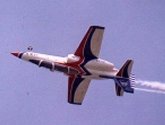
 In
March 1975, the AIDC began a study of an advanced jet trainer
to replace the aging T-33A. The program gained its momentum on
December 15, 1975, when the AIDC signed an agreement with Northrop
to co-develop a single-engine jet trainer; the prototype was
designated XAT-3. The change from the original single-engine
layout to the current twin-engine design was approved by the
Ministry of National Defense on June 13, 1976. Two prototype
aircraft were built.
In
March 1975, the AIDC began a study of an advanced jet trainer
to replace the aging T-33A. The program gained its momentum on
December 15, 1975, when the AIDC signed an agreement with Northrop
to co-develop a single-engine jet trainer; the prototype was
designated XAT-3. The change from the original single-engine
layout to the current twin-engine design was approved by the
Ministry of National Defense on June 13, 1976. Two prototype
aircraft were built.
The first prototype 0801 (69-6001) first took off on September
16, 1980. The second prototype 0802 (71-6002) first flew on October
30, 1981. The first production example, re-designated AT-3, 0803,
was rolled out in an official ceremony on March 1, 1984. To boost
morale, the aircraft was named Tzu Chiang, meaning in Chinese
gaining strength without relying on others. It had made its first
flight on February 6, 1984. Delivery began in March 1984, completed
in 1990. More than sixty AT-3s were ordered. There was also a
single-seat dedicated attack version, designated A-3, but its
program was cancelled after two prototype XA-3s (0901, 0902)
were built.
There are two zero/zero Martin-Baker 10 ejection seats in the dual-control cockpit of production models. The ejection seats on the prototype were of Northrop design. The crew of two sit in tandem, with the rear seat elevated 30 cm. All AT-3s use MDC systems to break the canopy in emergency. Basic construction is metal but with laminated graphite composite airbrake panels and metal honeycomb core ailerons. The two prototypes 0801 and 0802 were equipped with unspecified interim engines. Published photographs showed the tailpipes protruded from the engine nacelles. The power plant for production models was changed to two Garrett TFE731-2-2L non-afterburning turbofan engines, producing a total thrust of 3178 kg (31.1 kN; 7000 lb). The maximum external load is 2721 kg (6000 lb). AT-3s have five hardpoints (one centerline, two inboard underwing, two outboard underwing) and wingtip launch rails. Weapons that have been seen carried by the AT-3 include Mk 82 500 lb bombs, Mk 20 cluster bombs, 5 in and 2.75 in rocket pods, 20 mm gun pods, and heat-seeking air-to-air missiles including the AIM-9 and the Tien Chien (Sky Sword) 1 developed by the CSIST.
The AIDC retained several XA/AT-3s for test and evaluation of new systems. It is known that the second XA-3 prototype 0902 was installed with the APG-66T radar and the fire control system for the Hsiung Feng (Strong Wind) 2 anti-ship missiles. The cockpit was dominated by two multi-function displays (MFDs) on both sides of the front panel, with some conventional instruments between and above them. A head-up display (HUD) with up-front controls was also installed. Another feature was the hands-on-throttle-and-stick (HOTAS) control. The AT-3 0825 (75-6025) also received the same modifications.
Operators of the AT-3 include ROC Air Force Academy, Thunder Tigers Aerobatics Demonstration Team, and the 35th Night Attack squadron, all at Kangshan. At ROC Air Force Academy, student pilots choosing the Fighter track fly the AT-3 for 110 flying hours. The 35th used to operate from Hsinchu AB. In the winter of 1995, it moved to Kangshan to share the maintenance facilities there.
Nation of Orgin: Taiwan
Constructor: AIDC and Northrop
Type: Trainer/Light Attack
Crew: 2
Wing span 10.46 m (34 ft 3 1/4 in)
Length 12.90 m (42 ft 4 in)
Height 4.36 m (14 ft 3 1/4 in)
Weight (empty): 3855 kg (8500 lb)
Max take-off weight: 7938 kg (17500 lb)
Engines: Two Garrett TFE-731-2-2L nonafterburing turbofans, rated 15.57 kN / 3500 lb each
Max speed: Mach 0.85
Range (max internal fuel): 2279 km (1416 miles)
Armament: cluster or fire bombs, flare dispenser, rockets, AIM-9,
TC-1, Hsiung Feng 2 ASM